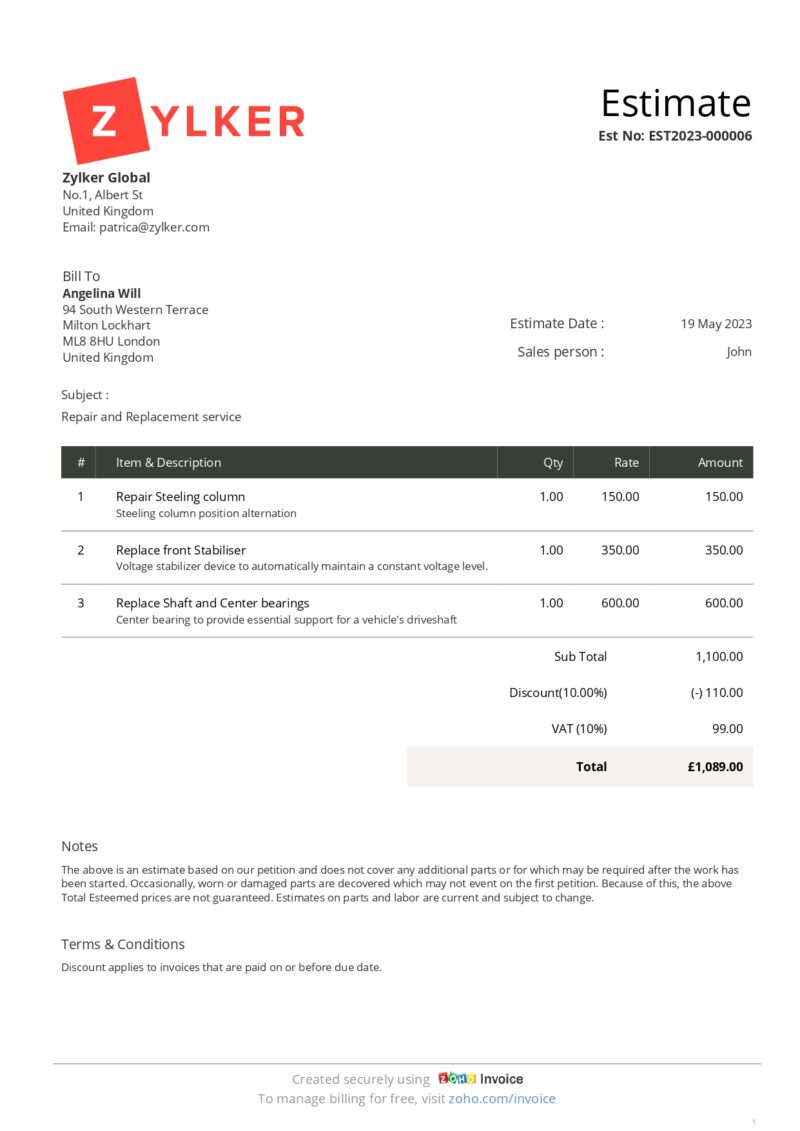- HOME
- Invoicing operations
- How to write professional estimates: A guide for small business owners and freelancers
How to write professional estimates: A guide for small business owners and freelancers

You're a freelancer who just landed a new project. You are excited and have already begun to chalk out a mindmap about how you're going to deliver your best work. However, before you dive in headfirst, there's one crucial step you shouldn't skip: creating an estimate.
An estimate provides an outline of the approximate cost of a project or service and provides your clients with a clear understanding of what they can expect from your business. Essentially, it is a price tag for your services.
While it helps your customers make an informed decision, creating an estimate helps you, as the business owner, draw a feasible roadmap for the project. By breaking down the whole project into smaller tasks and estimating the time and resources needed for each one, you can have a more realistic timeline to complete the project. This helps you avoid over-promising and under-delivering, building trust and transparency with your clients.
Whether you're a seasoned business owner or just starting, having a thorough understanding of creating a professional estimate is crucial. In this guide, we'll walk through the concept of an estimate, the importance of creating one, the elements that make a winning estimate, and the factors to consider before formulating one.
What is an estimate?
An estimate is a document provided to prospective clients detailing the anticipated duration, expenses, and resources required to complete a project. It represents the most practical approximation of a project's anticipated expenses and serves to align the client's anticipations with the business's ability to deliver the final product.
Estimates are utilized across various businesses, such as IT, construction, manufacturing, and accounting firms. While the elements of a professional estimate may vary depending on the specific business, they typically include the overview of the services offered, significant project deadlines, material and supply costs, and the projected total cost.
Why is it important to create an estimate?
Accurate estimation has a decisive impact on profitable contracting and proves advantageous in many aspects yielding multiple benefits. Here are some of its benefits:
Facilitates better budget and planning
Accurate cost estimation and budgeting are essential for businesses to make informed decisions about a project's feasibility. For instance, suppose you're a freelance writer and your new project includes writing a 10,000-word eBook for a client. Before diving into the project, you need to estimate the time and cost required to complete the work. Considering factors like the complexity of the topic and the time required for research, writing, and editing the content, you might estimate that it can take approximately 50 hours to complete the eBook. Based on this research, you can determine your hourly rate and determine the total cost of the project.
Estimating your projects this way helps you create a realistic budget and ensures you are fairly compensated for your time and effort while clearly communicating the project scope, timeline, and cost, which can help avoid any disputes later.
Helps establish good client relationships
By presenting an estimate, you outline the project scope, breaking down the tasks, deliverables, objectives, practical timeline, and projected costs of a project. This helps clients get a clear picture of the expected costs and timelines across different components or stages of the project.
For instance, an estimate provided by a software development company specifying the features, functionalities, and integrations helps the clients visualize the end result and build trust in your company's understanding of their needs. Another example is an estimate from a construction company that includes a detailed breakdown of material and labor costs, permits, and other relevant expenses. Such transparent estimates are more likely to have confidence in the financial integrity of the project or entity. This trust is crucial for fostering and sustaining positive relationships with the clients.
With respect to transparent timelines, consider the example of a marketing agency whose estimate outlines the timeline for each phase of a marketing campaign, such as market research, content creation, advertising, and reporting. Such detailed timelines facilitate clients in aligning their own activities and resources accordingly.
Increases profitability
Professional estimates lay the groundwork for profitable project completion by facilitating businesses to come up with realistic assessments of costs, timelines, and potential revenue. Assessing the expected expenditure of each task this way throws light on the areas where negotiations can be fruitful and cost savings are possible.
Since estimation incorporates risk assessment, where potential uncertainties and dependencies that may impact the project timeline, cost, or quality are identified, it helps to minimize profitability. All these provide invaluable insights into pricing your services competitively and maximizing your profit margins.
What to include in your estimate
Your estimate should include all the right elements and relevant information to help your clients build trust in your business and make an informed decision. An estimate must have the following details:
The header is the most straightforward part. This is where you mention the project's title, estimate number, and the date of the estimate. Then include your business information (attach your company's logo, company name, address, email, and phone number), and your client's information.
Project descriptions should be included to clearly define the scope of work and provide a detailed breakdown of the tasks you will be doing if your clients approve your estimate. This includes the project's purpose, goals, and required services, and determines the estimated cost. All the particulars on what is included, and what is excluded in the project should be clear and agreed on by both parties. For instance, an estimate for a floor renovation project may explicitly indicate that the total cost excludes the vinyl floors on the second story of the house.
Timelines should outline the estimated start and completion dates of the project and include all the milestones by which significant progress can be observed. For instance, if you are a freelance web developer, your estimate can specify that front-end and back-end development will be completed by March, while the project completion with testing and implementation is expected to be ready by May.
Breakdownsof the total cost including the granular information of both labor and material costs involved in each step of the project workflow should be present too. Here, you need to itemize each cost element and provide a clear description for each of them.
- Labor costs are typically calculated by estimating the number of hours required to complete each task or phase of the project and multiplying it by the labor rate. This may also include any additional overtime charges, if applicable.
- Material costs include the anticipated expenses for any necessary equipment or supplies required to complete the project. This can encompass construction materials, software subscriptions, and hardware. Also, consider adding tax details, shipping fees, or other associated costs that the client should know about.
Payment terms should clearly state the total cost of the project, any deposit or upfront payment required to kick start the project, and the schedule for milestone payments or the final payment. Include details of discounts for early payment, late fees, or penalties in the estimate, too.
Terms and conditions related to the project, such as revisions, warranties, dispute resolution, or termination clauses should be included in an estimate. Ensure your clients are aware of their rights and obligations upfront.

Sample estimate
How to create a professional estimate?
Now that you understood the typical elements to be included in your estimate, let's see some of the factors that you should consider before creating professional estimates to ensure accuracy and effectiveness.
Understand the project requirements
Before creating an estimate, understanding the project requirements is crucial as it helps you accurately assess the scope, complexity, and resources needed to complete the project efficiently. The estimation process also helps you identify potential risks and challenges that may arise during the project, providing leeway to take contingency measures. This makes your estimates more reliable and realistic.
For instance, imagine you're a freelancing web developer, and your client wants you to create a website for their business. During the preliminary discussion, they provide limited information, such as the desired number of web pages and a general overview of the design they have in mind. Without knowing the specific requirements, it would be impractical for you to provide a realistic estimate. When you analyze the requirements in detail, you uncover that the client expects you to design an e-commerce platform and a backend system to manage inventory and process payments. Now armed with detailed requirements, you can consider factors like the number of pages, the complexity of design, e-commerce functionality, backend development, and other additional integrations to create a more realistic estimate of the project's timeline and cost.
Without a clear understanding of the project, you might have over-promised and under-delivered, leading to delays and frustrations that are financially and emotionally taxing on both parties.
Conduct cost research
Conducting cost research is the next step, where you establish a feasible budget and timeline for the profitable completion of the project. There are several stages to cost research, starting with thoroughly understanding the project requirements without any ambiguities.
First, assess the market, competition, and target audience to determine the optimal pricing strategy.
Next, research within your industry or niche to gather information on pricing and rates for similar projects. When determining the price point, consider factors such as project complexity, industry standards, value proposition, market demand, and geographic location.
Ensure to identify any project-specific expenses or overhead costs you might need to account for. This includes software licenses, stock resources, third-party services, hardware, travel expenses, or the need for subcontracting.
Finally, decide on a pricing structure, choosing between an hourly rate fee, a fixed project fee, or a mix of both. To calculate the hourly rate, multiply the estimated hours for each task by your hourly rate. If you opt for a fixed project fee, consider the overall project complexity, time commitment, and value you provide to the client.
Remember, cost research is an ongoing process; it's essential to keep updating your knowledge and adjusting your pricing strategies based on market trends, client feedback, and your experience.
Have a contingency plan
Contingency planning helps you account for unforeseen events or changes that might impact the timeline or scope of the project. These potential risks might come in the form of technology dependencies, client availability, external dependencies, regulatory changes, or resource constraints.
For instance, as a freelance web developer, the delay in the client's website content might pose a potential risk to project completion as per the estimated deadline that might, in turn, affect the development and testing phases.
Once potential risks are identified, assess the probability of them occurring, and estimate their potential impact on the project. Then categorize risks based on their likelihood and severity.
For instance, you can assess the probability of the website content being delayed as high, say 70%, and the impact as moderate, which means you might need an additional week of development and testing. In the same way, estimate contingency costs due to expenses for additional resources, extended project duration, or expedited services. Document all the assumptions and dependencies made during the estimation process and communicate your contingency plan to the client, ensuring transparency.
Key takeaway
An estimate professionally represents your business and the value you bring to clients who choose to do business with you. When prepared correctly, it serves as a strategic tool for efficient planning, optimal resource allocation, and increased profitability. Moreover, it establishes realistic expectations for clients, enabling them to make informed decisions and promoting transparency throughout the project.
However, if you're just starting out, creating a project estimate can feel overwhelming. Fortunately, with the right solution, you can create compelling and accurate estimates that not only attract long-term clients but also help you thrive in the dynamic world of business. Zoho Invoice could be the perfect solution you've been searching for!
Note: Although estimates are interchangeably used with the term "quotes" or "quotations", estimates are more of a rough approximation of the potential cost for a project, giving the clients your best guess, while a quote provides a fixed evaluation in a way that when your client approves the quote, you are obligated to perform the work for the agreed-upon price.
Zoho Invoice empowers you to customize and generate professional quotes in your client's currency. You can easily discuss, negotiate terms, and seek approval for your quotes through the client portal. Once the project is complete, converting an approved quote into an invoice is a breeze with just a single click, transferring all the relevant details seamlessly.
The best part is you can use Zoho Invoice to create professional quotes and streamline your entire invoicing process at absolutely no cost forever!
Experience Zoho Invoice today.
